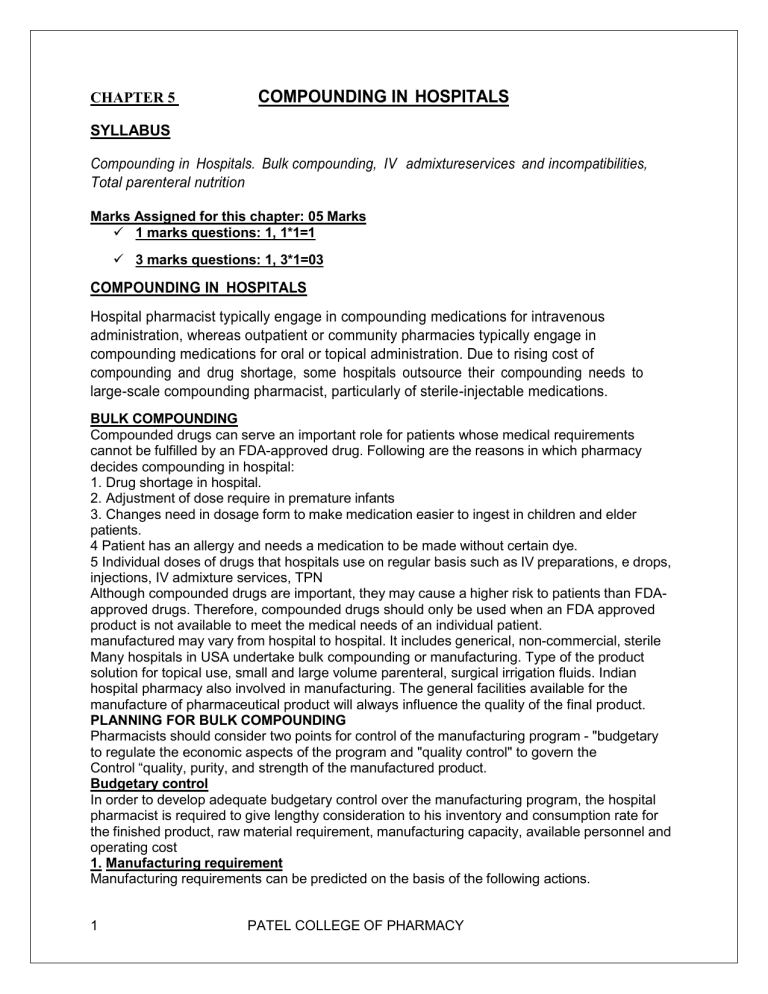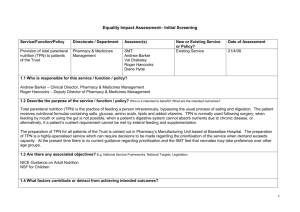
CHAPTER 5 COMPOUNDING IN HOSPITALS SYLLABUS Compounding in Hospitals. Bulk compounding, IV admixtureservices and incompatibilities, Total parenteral nutrition Marks Assigned for this chapter: 05 Marks 1 marks questions: 1, 1*1=1 3 marks questions: 1, 3*1=03 COMPOUNDING IN HOSPITALS Hospital pharmacist typically engage in compounding medications for intravenous administration, whereas outpatient or community pharmacies typically engage in compounding medications for oral or topical administration. Due to rising cost of compounding and drug shortage, some hospitals outsource their compounding needs to large-scale compounding pharmacist, particularly of sterile-injectable medications. BULK COMPOUNDING Compounded drugs can serve an important role for patients whose medical requirements cannot be fulfilled by an FDA-approved drug. Following are the reasons in which pharmacy decides compounding in hospital: 1. Drug shortage in hospital. 2. Adjustment of dose require in premature infants 3. Changes need in dosage form to make medication easier to ingest in children and elder patients. 4 Patient has an allergy and needs a medication to be made without certain dye. 5 Individual doses of drugs that hospitals use on regular basis such as IV preparations, e drops, injections, IV admixture services, TPN Although compounded drugs are important, they may cause a higher risk to patients than FDAapproved drugs. Therefore, compounded drugs should only be used when an FDA approved product is not available to meet the medical needs of an individual patient. manufactured may vary from hospital to hospital. It includes generical, non-commercial, sterile Many hospitals in USA undertake bulk compounding or manufacturing. Type of the product solution for topical use, small and large volume parenteral, surgical irrigation fluids. Indian hospital pharmacy also involved in manufacturing. The general facilities available for the manufacture of pharmaceutical product will always influence the quality of the final product. PLANNING FOR BULK COMPOUNDING Pharmacists should consider two points for control of the manufacturing program - "budgetary to regulate the economic aspects of the program and "quality control" to govern the Control “quality, purity, and strength of the manufactured product. Budgetary control In order to develop adequate budgetary control over the manufacturing program, the hospital pharmacist is required to give lengthy consideration to his inventory and consumption rate for the finished product, raw material requirement, manufacturing capacity, available personnel and operating cost 1. Manufacturing requirement Manufacturing requirements can be predicted on the basis of the following actions. 1 PATEL COLLEGE OF PHARMACY Review the records of the previous year or two and compare this figure with the staffs present prescribing pattern. if, at the end of the first quarter, the pharmacist realizes that he has overestimated or underestimated his requirements. Whichever the case may be, corrective steps may be placed into effect for the second quarter, i.e., increase the rate or volume of production or reduce the batch quantity or frequency of manufacture or eliminate one batch of the product which is supposed to be above desirable inventory limits. 2. Material Requirements Once the hospital pharmacist has decided what products he plans to manufacture and in what quantity, he must take the next step for the procurement of the necessary supplies. These supplies include raw materials, containers, labels and supplementary materials such as filter paper, filter pads, boxes, and special labels. 3. Manufacturing Capacity Manufacturing capacity is depending on the availability of equipment and its capability to manufacture the desired quantity for manufacturing, Time is the costliest factor in manufacturing program benefits the pharmacist to utilize the maximum capacity of his equipment. Hence the selection of equipment should be made on the basis of multiple or variety of uses to which a single piece of equipment can be placed 4. Manufacturing Equipment and Its Source The size of manufacturing equipment in hospital pharmacy may vary from institution to institution. Manufacturing program must be consider, the quantities to be produced during any production the length of time that will be required to consume the product the availability of personnel the availability of physical facilities 5. Manufacturing Staff The manufacturing section of the pharmacy must be supervised by a technically competent, legally qualified pharmacist. In addition, he must be supported with ancillary personnel who can be trained to carry on such non-technical pursuits as bottling, filtering, labeling, etc. 6. Operating Cost Operating cost consists of direct cost only- direct labor and cost of material but it should include both direct and indirect cost. The terminology Overhead cost' is usually interchangeably with 'indirect cost. Quality Control Quality control is required to supervise the quality, purity and strength of the manufactured product that will ensure the integrity of product. This can best be accomplished by developing a series of cross checks and laboratory analyses. Hospital pharmacist has responsibility to follow CGMP for ensuring the high pharmaceutical standards of product. I V ADMIXTURE SERVICES AND INCOMPATIBILITIES IV ADMIXTURES These preparations consist of one or more sterile drug products added to IV fluids- generally dextrose or sodium solution or ringer solution alone or in combination. IV admixture are used for drugs intended for continuous infusion and for drugs that may cause irritation or toxicity when given via direct IV injection. definition: An 1V admixture is a preparation of a pharmaceutical mixture of two or more drugs added into IV fluids alone or in combination for medication purposes. Following objectives expected to achieve by the pharmacist for the implementation of an IV additive service: 1. Preparation of final product under aseptic condition. 2 PATEL COLLEGE OF PHARMACY 2. Rational choice of additive and mixing techniques for avoiding drug interactions. 3. Appropriate labeling, dispensing and storage of final product. PREPARATION OF IV ADMIXTURE 1. Upon receipt of the physician original order sheet, a pressure sensitive label must be prepared. which provides the following information: Patient name Patient location Physician's name Name of the drugs with quantities added Date of compounding Expiration date Name of the pharmacist preparing the product 2. Prepare the admixture under the laminar flow hood using sterile needles and syringes or double ended transfer needles. Sometimes the Cornwall syringe is also useful in the preparation of IV admixture. 3. Once the transfer is made, metadisc of the container must be replaced with a new seal crimped. For safety purposes, A different colored seal should be utilized that it warns individuals regarding drugs that have been added. 4. Pharmacists must inspect the final product before dispensing the final admixture. The inspection should contain a review of the label, clarity of the solution, and the calculation involved in the preparation. IV ADMIXTURE INCOMPATIBILITY Definition: It is the simultaneous dilution and/or administration of two or more drugs that interfere with the therapeutic efficacy of the medications and patient safety. The types of incompatibility related with intravenous administration are Physical incompatibility Chemical incompatibility Physical incompatibility (PI): It occurs when a drug mixture produces an observable modification in the appearance of a solution. It is also known as "Pharmaceutical Incompatibility or Visual Incompatibility'", Pls are noticed more easily by alteration in the appearance of admixtures such as the evolution of gas, precipitate formation, or change in color. This affects the solution unsafe for administration. Chemical incompatibility (CI): It occurs when the chemical degradation of the admixed drugs, which showed toxicity or therapeutic inactivity. Chemical degradation of drugs in Chemical incompatibility appears as change in colour, precipitation and turbidity. Therapeutic incompatibility may happen when two or more drugs are administered concurrently resulting in undesirable pharmacological activity. CAUSES OF INCOMPATIBILITY Incompatibility generally occurs between: Two drugs (drug-drug incompatibility) Drugs and materials of IV containers When these are mixed together in the similar infusion line or the similar IV container When these are administered one after the other in the same infusion line Drugs and unsuitable diluents Drugs and adjuvants such as stabilizer and solvent 3 PATEL COLLEGE OF PHARMACY Reasons of incompatibilities in IV admixture therapy CONSEQUENCES OF INCOMPATIBILITIES The unintentional presence of precipitation and toxic products can induce various negative impacts on the patient. The severity of the damage induced by incompatibility depends on the patient's condition (age, weight, the severity of the disease, etc.) and the type of drug administered. Major consequences of incompatibility are listed below: 1. Damage from toxic products Multi-organ failure, Severe liver dysfunction, Toxic shock, Local embolus, Myocarditis, Respiratory difficulties, Systemic allergic reactions, Local allergic reactions, Thrombosis, Thrombophlebitis, Phlebitis, Local redness 2. Particulate emboli from crystallization and separation A large quantity of particles in injections is considered a potentially life-threatening health hazard. Drug incompatibility reactions may not only produce particles in the infusion but also alter the drug into an inactive form and injurious effects on the patient prescribed drug regimen. 3 Tissue irritation due to major pH modifications 4 Therapeutic failures 5 Adverse effects of drug incompatibilities extend time span and total cost of patient's hospitalization in hospital. PHARMACIST ROLE IN INTRAVENOUS ADMIXTURE SERVICE 1. Permanent supervision and involvement of Clinical Pharmacist is essential in IV 1o admixture services. 2. Pharmacist prepare protocol for IV admixture service and establish reporting error system. 3. It provides expert advice on compatibility and stability for the use of multiple drugs if required for IV administration. 4. It updates staff on new clinical practice guidelines and help to interpret guidelines as they apply to patients with advanced disease. 5. It can prevent dangerous incompatibility through the available literature, databases, services and information material. 6. Color coding is given for preventing incompatibility and It also helps in clear indication drug separation. 7. Prepare individual labelling for each drug preparation. 8. It always checks the alternative methods of administration and uses multi-lumen catheters. 9. Appropriate use of inline filters can reduce the influx of particles that result from incompatibilities. 4 PATEL COLLEGE OF PHARMACY TOTAL PARENTERAL NUTRITION (TPN) total parenteral nutrition (TPN) is a method that bypasses the GIT gastrointestinal tract, because s absorptive capacity is reduced. Fluids are administered into a vein to deliver most of the nutrients the body needs. In short, when the GIT is non-functional, TPN is essential for patients to maintain adequate nutrition. TPN provides a mixture of fluid, electrolytes, carbohydrate, lipids(fats), amino acids (protein), vitamins, minerals. Definition: Total parenteral nutrition (TPN) is intravenous administration of nutrients in adequate quantities to achieve tissue synthesis & anabolism TYPES OF TPN Central Parenteral Nutrition Peripheral Parenteral Nutrition Central Parenteral Nutrition: It is also called total parenteral nutrition (TPN) that is delivered into a central vein. It includes lipids, vitamins. minerals, amino acids, dextrose & trace elements. Peripheral Parenteral Nutrition (PPN): PPN is delivered into peripheral vein. Total kcal is limited by concentration & ratio to the volume being administered. INDICATIONS FOR USE TPN medication only possible choice for patients who do not have a gastro intestinal tract functioning or who have disorders needing complete bowel rest, such as the following: 1. Inability to absorb nutrients via the gastrointestinal tract 2. Patient who is not expected to eat sufficiently 3. Moderate to serve pancreatitis when adequate enteral intake is not expected for 5 to 7 days Chronic intestinal obstruction as in intestinal cancer 4. Organ failures - liver, renal, respiratory 5. Malnourished oncology patients 6. When the patient is unable to sustain nutritional status due to severe diarrhea or vomiting 7. Malnourished patient before major Surgery 8. Inflammatory bowel diseases such as: Surgery-related short bowel syndrome, Ulcerative colitis, Crohn's disease, Severe diarrhea SITES OF DELIVERY TPN administration is through a central venous catheter that is placed in a large vein that goes directly to the heart (superior vena cava, right atrium, or inferior vena cava). TPN must be delivered in clean and sterile environment. TPN is generally used for 10 to 12 hours a day, 5 to 7 times a week. COMPLICATIONS The main complications can be due to metabolic abnormalities and related to central venous Access. Metabolic abnormalities Electrolyte imbalance Liver toxicity Re-feeding syndrome in chronic alcoholic patients Sudden discontinuation cause hypoglycemia Hyperglycemia over feeding Central venous access it is related with the insertion of central line catheter Pneumothorax Bleeding Air embolism Vascular injury 5 PATEL COLLEGE OF PHARMACY Thrombophlebitis Catheter site infections include bloodstream infection, local skin infection at insertion site CONTENTS OF TPN TPN is mixture of separate components which contain Carbohydrates, Lipids (fat), Amino acids, Electrolytes, Trace elements, Vitamins and Fluids. TPN composition adjusted as per requirement of individual patient. • Carbohydrates: Carbohydrates is the main source of energy. Dextrose and monohydrates of glucose used as primary source of carbohydrate in TPN. Carbohydrate source such as galactose, fructose & sorbitol should not be used as energy sources in TPN. • Lipids (Fat): Linoleic acid is used as primary source of essential fatty acid in TPN. Linoleic acid is useful as precursors of prostaglandins & in the synthesis of other fatty acids which are essential for cell membrane integrity. • Electrolytes: Sodium (Na) - 100 to 200 mEq, Potassium (K) - 80 to 120 mEq, Magnesium (mg) -8 to 16 mEq, Calcium (Ca) -5 to 10 mEq, Chloride (Cl) – 100 to 200 mEq. Vitamins: Vitamins are required for the metabolism of carbohydrates, proteins, fats. water soluble (Bl, B2, B3, B5, B6, B7, B9, B12 & C) & fat-soluble vitamins (A, D, E & K) used in TPN formulation. Labelling of solutions: Following information should be present on the prepared: Name of the drug, Strength, Instructions for use. Expiry date- The prepared solution is used before 24 hours (stability) and it is to be store in the refrigerator until the use. TPN solutions should not be combined with other IV solutions unless it is consulted with the pharmacist to determine compatibility (separate lines should be used). 6 PATEL COLLEGE OF PHARMACY

